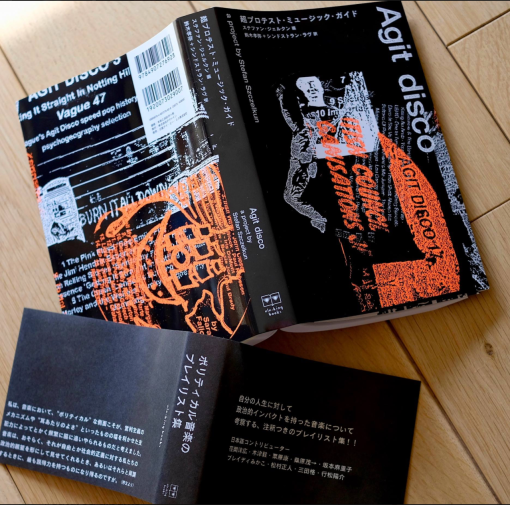
Out from 野田努(ele-king)
150-0031東京都渋谷区桜丘町21-2 池田ビル2F
株式会社Pヴァイン内ele-king編集部
03-5784-1256
http://www.ele-king.net/
The new Japanese selectors are:
Hiroshi Egaitsu, Kizu Tsuyoshi, Kurihara Yasushi,
Kuwahara Moichi, Sakamoto Mariko, Koya Suzuki with Love Kindstrand, Brady Mikako,
Masato Matsumura, Yosuke Yukimatsu, Itaru W. Mita,
Good that writers in Japan were actively engaged as selectors! You can follow the name link to my short comments on parts of their playlist and a photograph or two of their pages.
Its a pity that the new edition couldn’t have included:
https://szczelkuns.wordpress.com/…/french-agit-disco-2014/
and
http://archive.furtherfield.org/features/reviews/agit-disco-vs-zombie-apocalypse
but they are linked to in the afterword… http://stefan-szczelkun.blogspot.co.uk/2018/02/afterword-to-new-japanese-edition-of.html
The new Afterword basically a concentrated summary of the agitdisco posts I’ve done since the UK book came out… here and on Youtube!

Conclusion: Of course there are many other questions that may or may not have been answered by these new selectors. It seems that the Hardcore Japanese punk bands in the 1980s had a level of protest – examples are SS, The Stalin and GISM. Was/is hip hop and rap absorbed into J-Pop without any of the oppositional content of global non-commercial hip hop culture? Going back further, what about those early ‘hippy’ era experimental bands like Les Rallizes Dénudés?
The post-war peace settlement seems to have had a dark shadow of USA cultural imperialism attached to it. For instance, I understand that it was only around the year 2000 that pop songs were sung in Japanese. Perhaps such subtle imperialist pressures stymie working-class musics and are the reason that Japanese people have insisted that there is ‘no Japanese protest music’.
The original English selectors were mainly my own contacts with others added who were friends of friends. So the British group of selectors probably had some cultural values in common. I have no idea how the Japanese selectors came to be assembled or who invited them to contribute; I was not involved. Anyway the point is that, whether they knew each other or not, they have a completely new approach to the idea of Agit Disco. This adds to the genre busting diversity that was one of the values of the first edition.
http://www.ele-king.net/books/006107/


